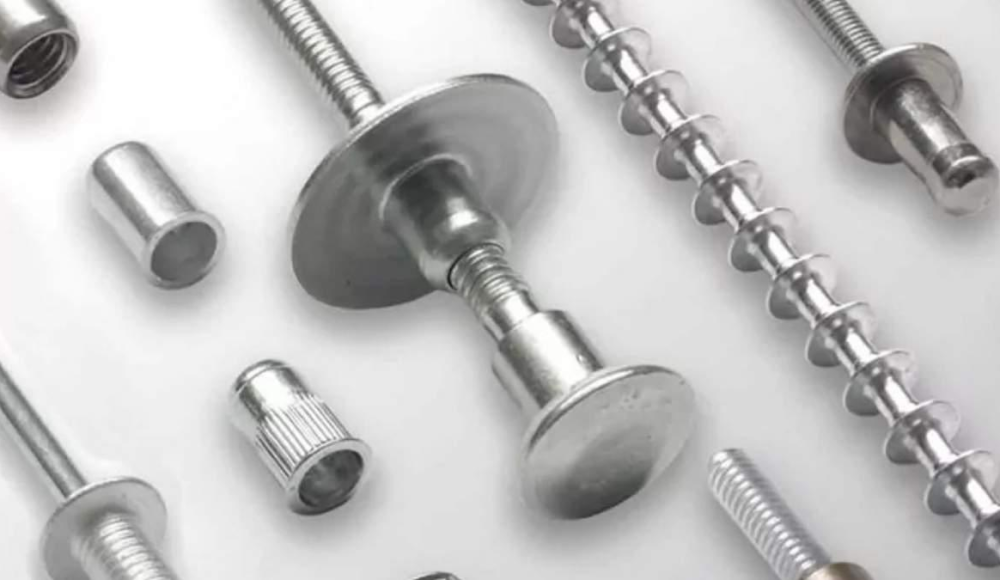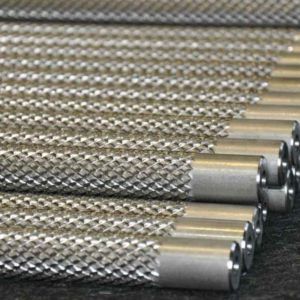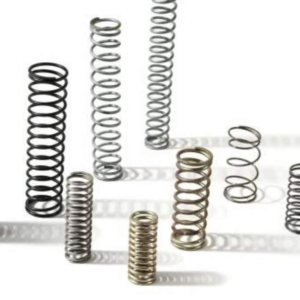Rebites são usados durante a montagem de componentes. Pilhas de submontagens se unem para formar uma montagem. These parts are easily organized through specific tools. In this context, parafusos are identical fastener types. Several rivet variants are available in the market to suit the intended design purposes for specific applications. These fasteners offer excellent clamping force for different uses. Rivets are used in both lightweight operations and where high loads are applied. In the same respect, rivets also easily deal with the tensile and shear forces of any materials used in the construction of a particular structure. Let’s dive into the details of rivets!
What is a Rivet?
A rivet is typically used in sheet metal fabrication. These are employed to join two or thin metal plates together through mechanical fastening. Geralmente, it has a head and a tail on two ends of the currency or at least on the obverse and reverse sides. Rivets can be produced from latão, cobre, aço, ou alumínio. No entanto, there’s a misconception about rivets. They are different from bolts by their ability to fasten metal sheets. Além disso, when it comes to connecting parts that are intended to create a long-lasting relationship.
How Does a Rivet Work?
Rivets are essential for constructing buildings and machines. The installation begins with the use of bits to drill holes. In installation, the tail of the rivet is placed at the hole. The end of the rivet is then put under deformation. This technique uses a factory head, which refers to the original head. When inserted the tail creates a new head which is called the ‘shop head’. A hammer is used to push the tail sideways to make it broader to hold the rivet in place. The intended process is called buckling.
Stepwise Installation Process
To install a rivet correctly, follow these steps:
- Etapa 1: Choose the appropriate rivet type you ought to use with your specific parts. Think about the type of material and size which is necessary.
- Etapa 2: Determine where the rivet should be installed to simplify joint assembly.
- Etapa 3: Drill a hole approximately 1.5mm larger in diameter than the rivet being used.
- Etapa 4: Insert the rivet through the drilled hole to join two or more materials.
- Etapa 5: Ensure the tail begins at the other end of that part.
- Etapa 6: Fold the upper part of the tail and hammer until flat. The tail should be flexed so that it is about 1 and a half times the size of the original length.
Materials Used for Rivet Production
The choice of material with optimum mechanical properties is critical for rivet performance. Here are common materials for riveting includes;
Aluminum Rivets
Aluminum rivets are used often, desde, they are light, easily available, and can bend precisely. These can be exploited in many applications because aluminum is not affected by corrosion. Além disso, the material is ductile, enabling the production of complex shapes with ideal wall thickness.
Stainless Steel Rivets
Stainless steel rivets provide remarkable strength and excellent corrosion resistance. These properties are crucial, especially in aerospace applications for example in locomotives and power generation. Stainless steel rivets are preferred by manufacturers due to their capability in handling high working conditions.
Steel Rivets
Steel rivets are well embedded in different applications. Low carbon steel characteristics make them more appropriate for many use cases. These rivets are more flexible than the high-carbon steel rivet types. High carbon steel rivets, no entanto, consume more material in the manufacture and hence entail some impact on moldability.
Brass Rivets
Brass is an extraordinary material with low friction coefficients. These rivets feature high levels of strength and do not corrode easily as one would expect. Avançar, brass is non-sparking and therefore suitable for use in gaseous appliances such as cookers and water heaters.
7 Types of Rivets Employed in Manufacturing
A wide variety of rivet designs are available in the market, and each type is designed for specific uses. Below are seven common rivet types used in sheet metal work:
1. Solid Rivets
Rod rivets, also identified as round rivets. They are commonly used fasteners. Tipicamente, solid rivets entail two components: a shaft and a head, and are normally made from aluminum, aço, ou cobre. Some of the many uses of it are aerospace, eletrônicos, marinho, and mechanical.
2. Rebites cegos
Blind rivets are cylindrical and have a central mandrel. Their design enables it to be inserted in holes that have been drilled in advance. A rivet gun pushes the mandrel through the rivet to flatten the tube to hold the sheets together. Some popular uses in electronics and aerospace industries due to their use in hard-to-reach places, blind rivets are perfect.If your project requires the use of a large number of blind rivets, purchase them from blind rivet manufacturers.
3. Drive Rivets
Drive rivets also entail a mandrel. Geralmente, a hammer and backing block are required to drive the mandrel through the rivet. This type is useful where holes do not go all the way through the application area. It uses drive rivets to fasten panels and also to secure nameplates if present.
4. Self-Piercing Rivets
Self-piercing rivets leave out the requirement of creating holes in the materials to be joined. It is due to their design that they are capable of getting to the first layer of the materials. A chamfered tip makes piercing easier. These rivets are suitable for applications where high stresses are to be expected and where at least one of the materials being joined is thin.
5. Split Rivets
Self-piercing rivets resemble split rivets or bifurcated rivets. These rivets are mainly used on pliable materials such as wood and leather. These should not be used for crucial activities, but are good for home fix-up projects. The sawed body allows it to penetrate materials without much difficulty.
6. Tubular Rivets
Tubular rivets consist of a head, shank, and a partially hollow tube. The head is welded to the hollow section by cold forming in the manufacturing process. Low-strength ductile metals are suitable for these rivets. It is widely used in commercial buildings.
7. Flush Rivets
Flush rivets, or countersink rivets designed to reduce the appearance of the countersunk part and the drag force that a car must overcome. These rivets are recommended for use on finished metal surfaces, such as aeronautics. Além disso, the rivets make for a smooth profile to increase aesthetics.
What are Rivets Used For?
Rivets are used in construction, automotive manufacturing, and aerospace applications to create strong, permanent joints between various materials.
Rivets in Aircraft
The construction of aircraft requires reliable and strong materials. Poorly fixed components can compromise the integrity of the structures. Riveting eliminates the possibility of fabricating wrong sizes or improperly aligned components. Rivets are especially used in the creation of smooth and lightweight contours of the aircraft. It also becomes useful when approaches to the joint ends are not feasible or may be difficult to achieve.
Rivets In Jewelry
Riveting is a central cold joining process employed for making jewelry items. Geralmente, both professional and amateur jewelers use riveting to assemble metal parts without the involvement of soldering. Riveting is simple, and jewelers can easily follow the instructional videos while using simple metalworking skills & ferramentas.
Rivets In Joints
Rivets are known to be very effective in construction. They offer a complex solution to connect different machine and structural parts. In cabinets, wooden shelves, and lockers, connections made using rivets are durable more than screws. If applied in the construction of furniture, rivets guarantee durability as they keep the construction strong over a long span.
Rivets In Home Building
Seeing rivets in your home, you may find them in different places, and mostly, people do not pay attention to them. These fasteners are mostly used in roofing through fiberglass; they are used to join glass panels. Também, rivets are used in building construction of the gutters because they are more reliable than nails in holding the metal sheets. They also provide the fabrication of window blinds, wind guards, portas, hangar straps, etc..
Riveting vs. Soldagem: Qual método você deve escolher?
Riveting vs. welding are efficient joining technique with specific strengths and limitations. Portanto, it’s important to have a clear appreciation of the various options so that the right one can be used in the projects. Following is a comparative account of riveting and welding for the convenience of the readers.
| Fatores | Riveting | Soldagem |
| Materiais | Riveting excels at joining dissimilar materials. | Not ideal for materials with differing properties. |
| Custo | Riveting tends to incur higher operational costs. | Welding is generally a more cost-effective option. |
| Formulários | Commonly used in consumer goods, aeronave, construção naval, and bridges. | Preferred in defense, aeroespacial, and electrical sectors. |
| Força | Riveting may not suit applications needing rigid frames. | Welded joints are strong and permanent, ideal for rigid structures. |
| Velocidade | Riveting involves multiple steps, which can slow processes. | Welding offers efficient, automated joining of metal parts. |
| Segurança | Riveting is considered a safer method overall. | Welding poses risks due to the use of heat. |
Conclusão
Rivets serve as a viable alternative to bolts, parafusos, e soldagem. They provide fastening strength and durability comparable to those materials. Precisão máxima offers a variety of rivet types for different applications. Choosing the right rivet material and type is essential for project success.



